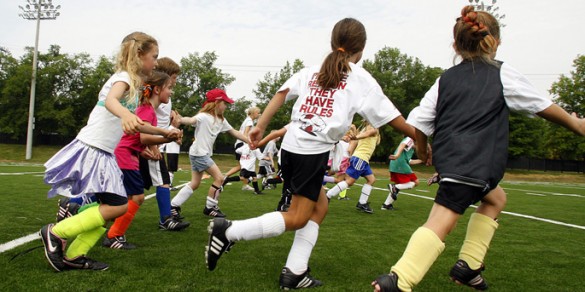
The increased emphasis on success in youth sports has made overuse injuries more common. With concerns mounting as children train harder, compete more frequently and specialize in a single sport earlier, the American Medical Society for Sports Medicine (AMSSM) has released a position statement that provides guidance to health providers who care for young athletes.
“Sports are such a good thing for kids, teaching them teamwork and helping their growth and fitness. We want to be sure that their participation is positive and healthy,” said Andrew Gregory, M.D., associate professor of Orthopaedic Surgery and Rehabilitation and Pediatrics at Vanderbilt University Medical Center.

Gregory is one of seven sports medicine physicians convened by the AMSSM to prepare the position statement. They reviewed 953 papers and cited 208 unique references in their final analysis.
It is estimated that 60 million children ages 6-18 participate in some form of organized athletics, with 44 million participating in more than one sport.
The study found the prevalence of overuse injury varies by specific sport, ranging from 37 percent in skiing and handball to 68 percent in running. The authors believe injury numbers may be under-reported because most injury definitions focus on time lost from sport and not all overuse injuries initially require time off.
The authors found no clear evidence that early sport specialization increases the rates of overuse injury and burnout, but believe that diversified training during childhood may be more effective in developing elite-level skills.
“We believe that doing a variety of activities in the early years helps with the fundamentals like balance, coordination, agility and reaction time. Then kids have a solid foundation when they are older and want to focus on one or two sports,” Gregory said.
The position statement reveals multiple risk factors for overuse injuries:
• Priory injury and higher training volumes are strong predictors of future overuse injury.
• Injuries are more likely to occur during the adolescent growth spurt.
• Adolescent female athletes who have irregular menstrual cycles are predisposed to bone-stress injuries.
• Poor-fitting equipment and overscheduling (such as multiple competition events in the same day or over consecutive days) may contribute to overuse injury but lack clinical data.
“The bottom line is that youth sports have gotten very competitive, and the increased pressure to excel has led to higher intensity training at younger and younger ages. But focusing so heavily on a certain sport, instead of more general fundamentals and skills, can lead to overuse injury and burnout,” Gregory said.
“Overuse Injuries and Burnout in Youth Sports” was published in the January issue of the Clinical Journal of Sports Medicine. The AMSSM also prepared an infographic on the recommendations.















